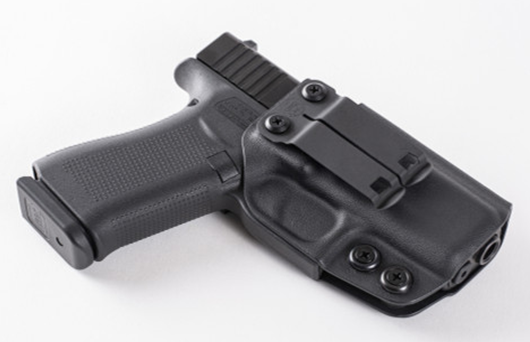Glock 19 vs. 43: How Do They Compare?
Dec 22nd 2023

The Glock 19 and the Glock 43 are two of the most popular 9mm pistols in Glock’s catalog and two of the highest-selling models in the company’s history. While they appear to fulfill similar roles at first glance, there are several differences between the two Glocks.
From concealability to everyday practicality, each pistol fills the holsters of different shooters for different reasons. Read our Glock 19 vs. 43 comparison and discover how each handgun performs in every key area for everyday gun owners.
Overview of the Glock 19
The Glock 19 (G19) is one of the most well-known pistols available in the Glock catalog. Barring the differences between each model generation notwithstanding, the G19 is the second-oldest model available to U.S. shooters.
The first Glock 19 was introduced in 1988 and was what is known today as a Gen 1 model, like the original Glock 17. It has since been updated with every subsequent new Glock Generation.
A few months after its introduction, the Glock 19 gradually received the changes introduced with the Generation 2 Glock 17. Glock updated it to Gen 3 in 1998, Gen 4 in 2010, and Gen 5 in 2017. In total, the pistol has been in production for over 35 years, during which it gained a large following among military, police, and civilian enthusiasts.
Initially, the Glock 19 was conceived as a backup gun and primarily marketed to law enforcement agencies as a smaller, more easily concealed alternative to the Glock 17. Over the years that followed, and especially after the pistol gained popularity in the United States market, it emerged as a popular choice for civilian concealed carry.
Today, the Glock 19 is often regarded as a gold standard among concealed-carry weapons. Glock enthusiasts often call it the Goldilocks gun because it offers an excellent balance of accuracy, high capacity, comfort, lightweight design, and concealability.
Even over 30 years after its introduction, the G19 remains a highly popular handgun. It routinely makes the list of top-selling firearms in the United States, as it did in 2020, 2022, and 2023.
Glock 19 Specifications (Generation 5 Model)
- Product family: Compact
- Caliber: 9x19mm Parabellum
- Overall length: 7.28”
- Barrel length: 4.02”
- Height: 5.04” with standard 15-round magazine inserted
- Width: 1.34”
- Standard capacity: 15+1. Also accepts Glock 17 magazines.
- Weight: 23.62 oz. with an empty magazine inserted
- Trigger pull weight: Approx. 5.5 lbs.

Overview of the Glock 43
Following rumors at SHOT Show 2015 that Glock would reveal a new model later in the year, the Glock 43 (G43) was officially announced at the 2015 NRA Annual Meetings & Exhibits (NRA Show) in April 2015. It was then released on the civilian market the same month.
The Glock 43 can be viewed as a 9x19mm version of a previously revealed pistol in 2014, the .380 ACP Glock 42. Although the G43 has slightly different dimensions than the G42, they are part of the same, then-new family of products: the Glock Subcompact Slimline pistols.
The primary trait distinguishing these new handguns from classic subcompact Glocks like the G26 is the frame and magazine design. Rather than shorten the original Glock 17 down to a concealable form factor, the Slimline pistols feature entirely bespoke, slim frames. They contribute to the pistols’ thinner and lighter frame but can only accept newly designed single-stack magazines.
This meant the Glock 43 could not accept previously released, widely available magazines compatible with the G26, G19, or G17. However, the Glock 43 is among the lightest pistols in Glock’s lineup and the lightest 9x19mm model ever produced.
Although it seems as though the G43 competes with the G19 in many respects, it became one of the most commercially successful Glock pistols. The G43 answers the needs of shooters who need a lighter, smaller, and generally easier gun to carry than the G19.
According to a Glock press release, the Austrian gun manufacturer sold over a million units within the first three years after its introduction.
Glock 43 Specifications
- Product family: Subcompact Slimline
- Caliber: 9x19mm Parabellum
- Overall length: 6.26”
- Barrel length: 3.41”
- Height: 4.25” with standard 6-round magazine inserted
- Width: 1.06”
- Standard capacity: 6+1.
- Weight: 17.99 oz. with an empty magazine inserted
- Trigger pull weight: Approx. 5.5 lbs.

Glock 19 vs. 43: The Ultimate Comparison
While both handguns are generally intended for concealed carry, distinguishing the differences in performance between the Glock 19 and the Glock 43 is crucial. Here is a breakdown of their capabilities and how a typical shooter and concealed-carrying citizen can take advantage of either model.
Shooting Accuracy
The Glock 19 features a slightly longer barrel than the Glock 43: 4.02 inches, versus the G43’s 3.41. The Gen 5 version of the G19 also features the Glock Marksman Barrel (GMB), which Glock claims delivers improved accuracy over previous generations. From a purely mechanical point of view, the G19’s longer barrel is potentially slightly more accurate than its slimline counterpart.
However, this difference is unlikely to matter in practice and for most shooters. The Glock 19 and the Glock 43 are mechanically accurate and can produce tight groups at typical pistol engagement distances. The factors most likely to influence your accuracy are the choice of ammunition, sight alignment fundamentals, and your experience shooting either handgun.
Beyond typical combat distances, most shooters may find the Glock 43 harder to shoot accurately. However, it is not because the barrel is less accurate by nature. Instead, aligning the sights on a distant target is more difficult with a shorter sight radius. With enough practice and quality ammo, both pistols can print tight, accurate groups at up to 25 yards.
Frame Size and Shooting Comfort
Though both are compact pistols, the G19 and the G43 are part of fundamentally different size classes. The Glock 19 is part of Glock’s traditional Compact line, one size smaller than the Standard pistols.
While Glock Compacts are shorter and lighter than a full-size model like the Glock 17, they remain relatively large. The frame thickness, designed to accept double-stack magazines, can make it more challenging for shooters with smaller hands to fully and confidently grip the G19. A proper, full grip is necessary to shoot as accurately as possible and control recoil efficiently.
This issue is part of the concerns the Slimline pistols, such as the Glock 43, are designed to address. The thinner frame and slimmer magazines allow shooters with smaller hands to grip the handgun fully, giving them better recoil control and accuracy.
Weight and Recoil Control
Besides grip size, another factor to consider is overall weight. An unloaded Glock 43 is 5.63 ounces lighter than an unloaded Glock 19. Due to the magazine capacity differences, a fully loaded G43 cannot reach the weight of a fully loaded G19.
Glock’s statistics estimate a G43 with a loaded magazine weighs just over 20.6 ounces, whereas a G19 can reach as high as 30 ounces. Although they may seem minor differences, the G19’s heavier construction is better suited for absorbing recoil, making follow-up shots and sight realignment easier.
The effects of recoil and the corresponding differences may be more apparent when using high-pressure self-defense ammunition, such as 9x19mm cartridges with a “+P” rating.
If you regularly use +P ammunition in your concealed-carry Glock 19 or a pistol of equivalent dimensions, try loading the same cartridges in a Glock 43. You may experience more muzzle rise and find it more difficult to return your sights on the target as quickly as with the larger handgun.
If the differences are more than you are comfortable with, consider switching to standard-pressure or lower-velocity ammunition with the Glock 43. They will generate less recoil and make it easier to control the smaller pistol.
Controls and Ergonomics
Regardless of model or generation, most Glock pistols feature virtually identical controls: the trigger and Safe-Action safety system, a magazine release button, a slide release lever, and a takedown lever.
Models of the same size class also have identical or extremely similar frame and slide dimensions, making them feel equally similar in a shooter’s hands.
When comparing the Glock 19 and the Glock 43 on comfort and ergonomics, shooters must consider frame height, grip texture, slide serrations, and the presence or absence of removable backstraps.
The latest version of the Glock 19, the G19 Gen 5, features the latest changes to Glock pistol frames: removal of the finger grooves found on Gen 3 and Gen 4 pistols, a slightly flared magazine well to aid reloading, and front and rear slide serrations for easier racking.
The G19 retains the adjustable backstraps and square grip texture introduced by the Gen 4 pistols, making this iteration a good balance between the overall look and feel of older Gen 2 pistols and more modern versions.
The Glock 43 was introduced before Glock announced Generation 5 models, and the gunmaker has not updated the design since. This means the G43 follows the same design cues as Generation 4 subcompact pistols at the time.
The G43 features Gen 4-style frame texturing without finger grooves, removable backstraps, or front slide serrations. The standard magazine is designed to sit flush with the short frame; shooters with medium-sized hands or larger may be unable to wrap the pinky finger around it. Many shooters remediate this by using a magazine with an extended baseplate, providing more space for a full, four-fingered grip.
Reliability of the Glock 19 vs. 43
As is typical for most Glock pistols, the Glock 19 and the Glock 43 are considered reliable handguns. They are expected to function flawlessly under adverse conditions or with minimal cleaning and maintenance for thousands of rounds. Many news outlets and independent testers have found that when reliability issues did occur, they were generally caused by the ammunition rather than the gun.
While Glock recommends periodically replacing the recoil spring assembly on both models every 5,000 rounds, many shooters have experienced no issues shooting well beyond that point.
Magazine Compatibility
As an original Glock Compact pistol, the Glock 19 is compatible with its own G19-specific magazines and taller Glock 17-compatible magazines. It means the G19 can support a wide variety of factory and third-party magazines, with capacities ranging from the standard 15 rounds to 33 and beyond.
G19 owners can also install magazine extensions and magazine springs, further increasing the capacity of a magazine body. Common extensions are designated +1 or +2 and increase a magazine’s capacity by 1 or 2 rounds, respectively.
Due to the new, slim frame design, the Glock 43 could not use existing Glock 9mm magazines released beforehand, such as G17, G19, or G26 magazines. It is also incompatible with the magazines intended for later models, such as the G43X and G48.
The G43 can only use magazines specifically designed for it. OEM G43 magazines include the flush-fitting 6-rounder and the +0 extension model, which are physically taller but provide no extra capacity.
Concealability and Ease of Carrying
If you are primarily interested in Glock pistols for concealed carry, both handguns are generally good choices. However, their differences make them suitable for different carry methods and holster styles.
As one of America’s most commonly used pistols, the Glock 19 is suitable for any carry style or holster type. Most shooters can conceal-carry a G19 reasonably efficiently in nearly any situation, whether they prefer standard IWB holsters, appendix IWB rigs, or OWB holsters.
Shooters with smaller frames must keep the handgun’s size in mind and adapt their holster’s position and orientation to minimize printing.
Glock 19 pistols can also fit in holsters designed for the .40-caliber Glock 23, the .357-caliber Glock 32, the .22 LR Glock 44, and other 9mm models like the G19X and G45. This broad compatibility increases the number of suitable holster options.
The Glock 43 was primarily designed for maximum concealment. Its small size, slim frame, and low weight make it an ideal candidate for deep-concealed IWB carry. Although it requires Glock 43-specific holsters, they are easier to conceal than G19 equivalents. The G43 is generally regarded as the easiest to carry and the most comfortable of the two for concealed carry.
Shop Highly Concealable Glock Holsters at Incognito Concealment
Whether you prefer the versatile Glock 19 vs. the 43 and its slim and lightweight design, Incognito Concealment carries the low-profile holsters you need. We offer an assortment of high-quality Kydex holsters for IWB and OWB carry that are compatible with most Glock pistols and a large selection of other handguns.











